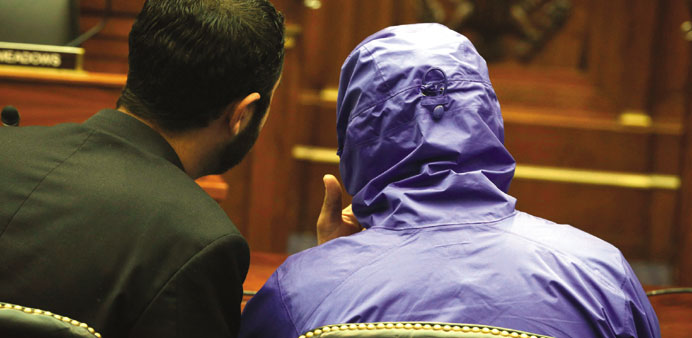Syrian Army defector ‘Caesar’ (right) listens to an interpreter during a briefing before US House Foreign Affairs Committee on Capitol Hill in Washington, DC.
Graphic images of the brutal conflict in Syria were displayed before US lawmakers yesterday as an army defector gave an eyewitness account of the horrors he was forced to photograph.
“I am not a politician and I don’t like politics... and neither am I a lawyer,” said the former Syrian military police photographer who escaped from Syria last year, bringing with him some 55,000 photographs taken as part of his job to catalogue the dead.
“I had the job of taking pictures of all the deaths... before and after the revolution,” explained the man known only as Caesar, who appeared in heavy disguise before the House foreign affairs committee to brief them on the war.
He was required to download the photos and store them on state computers to document the battle against the rebel opposition by the regime of Syrian President Bashar al-Assad, now in its fourth year.
“I have seen horrendous pictures of bodies of people who had tremendous amount of torture,” Caesar told about 100 people who listened in heavy silence. Around them on easels were six enlarged photos showing naked, skeletal bodies lying on the ground.
Most had been stretched out in meticulous rows, some bearing white labels attached around their wrists, all with their faces blanked out. A few still wore underpants, but most were naked.
Speaking through an interpreter, Caesar told of seeing corpses with “deep wounds and burns and strangulations” - some of which had “their eyes carved out” and others that were “emaciated and skinny.”
“They were starved to death and their bodies looked like skeletons. These people died of starvation,” Caesar said, adding he had never seen anything like it except for images taken during the Nazi regime in World War II.
“Sometimes I would come across pictures of my own neighbours and some of my friends that I recognised,” he told the hushed room, with his profile barely visible under a blue hooded jacket, with the hood’s drawstring drawn tight and a cap underneath and a pair of sunglasses.
“Death would have been my fate if the regime had found out I was leaking out secret information.”
More than 170,000 people have been killed since the uprising began in March 2011, and millions have fled both within the country or to refugee camps abroad.
Committee chairman Ed Royce said: “The conflict has created unimaginable human suffering.”
“One cannot see images like these and not ask, ‘What can be done?’ Answering that isn’t easy,” Royce said, adding the briefing was “a vivid and depressing reminder that while action can be costly, so too can inaction.”
Caesar said he had sent a letter to US President Barack Obama, urging him: “Please don’t forget those still in jail, including children. Please make sure they get released and don’t get tortured.”
He maintained some 150,000 people were still in Syrian jails, facing the same fate as the lifeless bodies in his photos.
At his side was former special prosecutor David Crane, who tried Liberian president Charles Taylor and is now working on setting up a tribunal to bring those responsible for war crimes in Syria to justice.
“We rarely find smoking gun evidence, but that’s what we found,” Crane told the lawmakers, adding he and his team were “stunned by the magnitude of this.”

